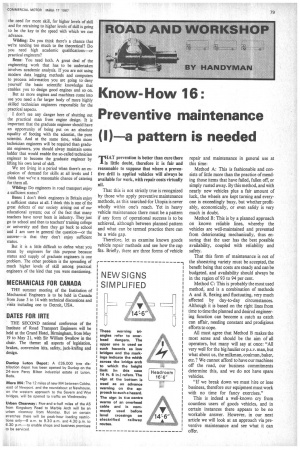Know-How 16: Preventive maintenance (I)—a pattern is needed
Page 81

If you've noticed an error in this article please click here to report it so we can fix it.
EAT prevention is better than cure there little doubt, therefore it is fair and reasonable to suppose that where a preventive drill is applied vehicles will always be available for work, with repair costs virtually nil.
That this is not strictly true is recognized by those who apply preventive maintenance methods, as this searched-for Utopia is never wholly within one's reach. Yet in heavy vehicle maintenance there must be a pattern if any form of operational success is to be achieved, although between planned pattern and what can be termed practice there can be a wide gap.
Therefore, let us examine known goods vehicle repair methods and see how the cap fits. Briefly, there are three forms of vehicle repair and maintenance in general use at this time: Method A: This is fashionable and consists of little more than the practice of mending those items that have failed, fallen off, or simply rusted away. By this method, and with nearly new vehicles plus a fair amount of luck, the wheels are kept turning and everyone is exceedingly busy, but whether profitably, economically, or even safely is very much in doubt.
Method 13: This is by a planned approach on known reliable lines, whereby the vehicles are well-maintained and prevented from deteriorating mechanically, thus ensuring that the user has the best possible availability, coupled with reliability and safety.
That this form of maintenance is not of the shoestring variety must be accepted, the benefit being that costs are steady and can be budgeted, and availability should always be in the region of 93 to 94 per cent.
Method C: This is probably the most used method, and is a combination of methods A and B, flexing and fluctuating, very much affected by day-to-day circumstances. Although it is based on the right lines from time to time the planned and desired engineering function can become a catch as catch can affair, needing constant and prodigious efforts to cope.
All must agree that Method B makes the most sense and should be the aim of all operators, but many will say at once: "All very well for the big haulier or p.s.v. man, but what about us, the milkman, coalman, baker, etc.? We cannot afford to have our machines off the road, our business commitments determine this, and we do not have spare vehicles.
"If we break down we must hire or lose business, therefore our equipment must work with no time for fancy exercises."
This is indeed a well-known cry from countless users of goods vehicles, and in certain instances there appears to be no workable answer. However, in our next article we will look at an approach via preventive maintenance and see what it can offer.








































































































































































































